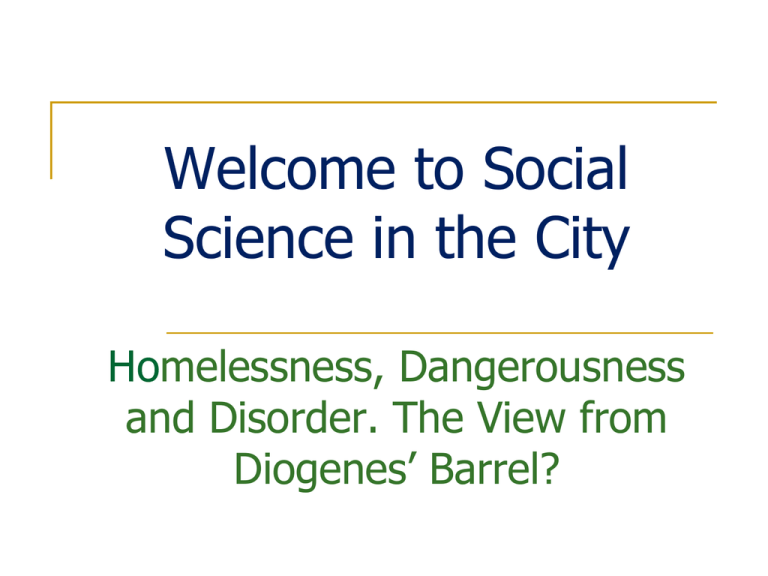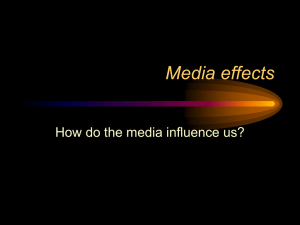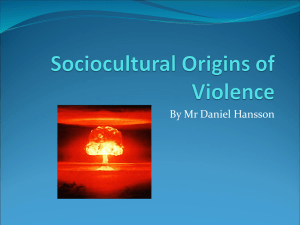Homelessness, Dangerousness and Disorder. The View
advertisement

Welcome to Social Science in the City Homelessness, Dangerousness and Disorder. The View from Diogenes’ Barrel? Homelessness, Dangerousness and Disorder. The View from Diogenes’ Barrel? Christopher Scanlon Consultant Psychotherapist & Organisational Consultant c.scanlon@btinternet.com Schwellenangst? To think about the ways in which some of us find ourselves (neither forced into nor by choice?) taking up our membership of a group either in opposition to it, by means of refusal to join in (the ‘anti-social position’), or at its edge, involving a ‘tightrope’ walk of fear and ambivalence (the ‘borderline position’) … Our society and your world: the difficulty holding onto “we” ‘Though a simple aspiration for most socially isolated people … the sense of belonging to a community with all this can imply for mutuality and participation remains stubbornly illusive in spite of community care’ (Morris, 2001) ‘... find themselves pushed to the margins of our society. Almost all encounter prejudice, bullying, insensitive treatment and discrimination [that leads to] your world becoming smaller, opportunities more limited, a withdrawal from wider society ...’ (Tony Blair, foreword to Valuing People, DoH, 2001) [our italics] “We are at war with one another”: Foucault’s Caesura … and - there’s a darkness of the edge of town ... (Bruce Spingstein) Foucault: Rupture and Caesura “We are at war with one another; a battle front runs through the whole of society, continuously and permanently” Society Must Be Defended, from Lectures at the Collège de France, 1975-76 Disturbances of ‘Groupishness’ “The individual cannot help being a member of a group even if his membership of it consists in behaving in such a way as to give reality to the idea that he does not belong to a group at all” “[man is] a group animal at war, not simply with the group, but with himself for being a group animal and with those aspects of his personality that constitute his groupishness” Bion, Experiences in Groups (1961) Foulkes – Location of Disturbance Each individual – itself an artificial though plausible abstraction is basically and centrally and inevitably determined, by the world in which he lives, by the community and the group … disturbance is between people – e.g. inclusion/exclusion and discourse of power relations ‘Symptoms’ are manifestation of what cannot be communicated between people Personality Disorder and Schwellenangst? “an enduring pattern of inner experience and behaviour that deviates markedly from the expectations of the individual’s culture” (DSMIV) “represent[s] either extreme or significant deviations from the way the average individual in a given culture perceives, thinks, feels and particularly relates to others” – “for different cultures it may be necessary to develop specific sets of criteria with regard to social norms, rules and obligations” (ICD-10) Diogenes of Sinope Agora – Forum (Forensic) “I brown-nose those who give me alms, I yelp at those who refuse, and I set my teeth on those who are rascals” ‘practising disappointment’ ... In search of one honest man ... The Diogenes Paradigm ... ‘If I were not Alexander ...’ Agoraphobic/claustrophobic dilemma? Intense longing for and profound fear of attachment (Glasser, 1996) The day came when the risk to remain tight in the bud it was more painful than the risk it took to blossom Anais Nin I was much further out than you thought And not waving but drowning. Stevie Smith – Not Waving But Drowning ‘In search of one honest man’...? “Please accept my resignation. I don’t want to belong to any club that will accept me as a member” ‘The existing social order is a swindle and its cherished beliefs mostly delusions’ (Orwell) ‘They sleep safely in their beds because rough men stand ready in the night to visit violence on those who would do them harm’ (Orwell) The ‘sturdy vagabond’ “The proletariat created by the breaking-up of the bands of feudal retainers and by the forcible expropriation of the people from the soil ... were turned in massive quantities into beggars, robbers and vagabonds ... Hence a bloody legislation against vagabondage was enforced ... Legislation treated them as ‘voluntary’ criminals, and assumed that it was entirely within their power to go on working ...” 1530: Beggar’s licence for the old and infirm – the ‘sturdy vagabond’ is tied to the cart-tail and whipped and then made to swear on oath to go back to their birthplace, or domicile of the last 3 years, and ‘put themselves to labour’ – three strikes and you’re out – executed as a ‘hardened criminal and enemy of the common weal’ Karl Marx: Das Kapital Foucault: The Leper and the Lazar-Houses “... the leper vanished, or almost, from memory ... Often, in these same places, the formulas of exclusion would be repeated ... Poor vagabonds, criminals and ‘deranged minds’ would take the part played by the leper, and we shall see what salvation was expected from this exclusion, for them and for those who excluded them as well.” Excluding by confining leads to fear of contagion “... all those forms of unreason which had replaced leprosy in the geography of evil, and which had been banished ... now became [via the presence of asylums in and near large cities] a visible leprosy ... Unreason was once more present; but marked now by an imaginary stigma of disease, which added its powers of terror.” (Foucault, 1961) Slavoj Zizek: ‘Objective Violence’ Subjective violence: violence performed by a clearly identifiable agent Symbolic violence: embodied in language and its forms, ‘imposition of universe of meaning’ Systemic violence: ‘the often catastrophic consequences of the smooth functioning of our economic and political systems’ “Objective violence is invisible since it sustains the very zero-level violence against which we perceive something as subjectively violent” Anti-social people or anti-social society? Behavioural violence and the antisocial position - injurious and offensive acts caused by specific actions of excluded individuals (clinical, psychological perspectives) Structural violence – the culture and organisation of groups, communities & societies that make it acceptable/desirable … increased rates of deaths and disability suffered by those who occupy the bottom rungs … (epidemiological – Gilligan, 1996) … ‘For the poor always ye have with you ...’ John 12:8 (we might add: violence ye will always have) The Sadistic Society … “…we hate them, and we hate them because they refuse and in their refusal are experienced as mocking everything that the mainstream of society holds dear: hope, selfbetterment, personal relationships, procreation, bringing up children, and even simply getting up in the morning. They are dirty, smelly, incontinent, and unsociable, and as such are an insult to our aspirations and our narcissism” (Declerk, 2006) Fear of Contagion “… the people here who, though they have an instinctive craving for human contacts, can’t bring themselves to yield to it, because of the mistrust that keeps them apart. For it’s common knowledge that you can’t trust your neighbour; he may pass the dis-ease [our hyphen] to you without your knowing it …” Camus, La Peste Perceptions and projections of dangerousness Real and imagined threats to psychic survival Plague, exile and quarantine Gated(?) communities and (in)security walls Border guards, quarantine officers and the surveillance society ‘Nursing dangerousness and dangerous nursing’: reciprocal violence and hostile dependency Fences Offences? “Every limit concept is always the limit between two concepts” Giorgio Agamben, Homo Sacer (1998) Schwellenangst? “One is inside then outside what one has been inside One feels empty because there is nothing inside oneself One tries to get inside oneself that inside of the outside that one was once inside once one tries to get oneself inside what one is outside: .... But this is not enough.” (RD Laing, from Knots, 1970) “[The madman’s] exclusion must enclose him ... he cannot and must not have another prison than the threshold itself ... He is put in the interior of the exterior, and inversely” (Michel Foucault, from Madness and Civilization, 1961) ‘The road to Hell is paved with good intentions...’ St. Bernard of Clairvaux (C11) Intentionally homeless - “not really homeless” – so not offered housing - threatens ideas of what it is to be ‘housed’ (lock ‘em out) Intentional self-harm [DSH] - “not really ill” threatens our idea of health - not offered healthcare (lock ‘em in – throw ‘em out) Intentionally unco-operative – ‘powerful’ helplessness (throw ‘em out) Intentionally anti-social – threatens our idea of social security – not offered treatment (lock ‘em up) … Intentionality Disorder? The road to Hell is paved with good intentions ..(St. Bernard of Clairvaux C11) Intentionally homeless - “not really homeless” – so not offered housing - threatens ideas of what it is to be ‘housed’ (lock ‘em out) Intentional self-harm [DSH] - “not really ill” - threatens our idea of health - not offered healthcare (throw ‘em out) Intentionally anti-social [ASBO]– threatens our idea of social security – not offered treatment (lock ‘em up) Intentionally ‘fat’: threatens our sense of ‘free-will and choice (send ‘em away) Intentionally stateless: seeking asylum and refuge from excesses of global greed – not seen as persecutory or traumatic (send ‘em back) … Intentionality Disorder? Knowing one’s place ...? Anti-social people who do not see themselves as patients, clients, services users, consumers and not in need of ‘treatment’ Incapacity to take up sick role – be in their ‘proper place’ -‘unpopular patients’, ‘pds’, ‘inappropriate attenders’, ‘heartsink’, ‘revolving door’, ‘patients that psychiatrists dislike’ Structural violence at heart of this cycle of rejection: - intensifies distress and maladaptive behaviour - impacts upon and impoverishes the capacity of services to engage the excluded The unremembered are dis-membered and exiled to realms of Unthought known Shame on who …? I have yet to see a serious act of violence that was not provoked by the experience of feeling shamed and humiliated, disrespected and ridiculed, and that did not represent the attempt to prevent or undo this “loss of face” no matter how severe the punishment … (Gilligan, 1996: 110) Evil doing …? I and the public know What all schoolchildren learn Those to whom evil is done Do evil in return W.H. Auden - September 1, 1939 “The centre cannot hold?” ‘Things fall apart; the centre cannot hold; Mere anarchy is loosed upon the world … The best lack all conviction, while the worst Are filled with passionate intensity’ W.B. Yeats – ‘The second coming’ Mere anarchy is loosed upon the world … Shame turns to contempt Grief turns to grievance Nihilistic as a defence against annihilation Violation turns to violence (disrespect) Violence is addictive and Addiction is violent (DSH) Leaning out last midnight on my sill I heard the sighs of men who have not the skill To speak of their distress, no nor the will … Wilfred Owen - The Calls (In)Security in a Time of Terror?: Bauman and Liquid Modernity Solid and liquid modernity and compulsive modernisation The emptying of the ‘agora’: “intermediary, public/private site where .... private problems are translated into the language of public issues and public solutions are sought, negotiated and agreed for private troubles” Post-Panoptical modernity: the end of the era of mutual engagement Liquid modernity: the revenge of nomadism over territoriality and settlement “it is the mind-boggling speed of circulation, of recycling, ageing, dumping and replacement which brings profit today – not the durability and lasting reliability of the product. In a remarkable reversal ... it is the high and mighty of the day who resent and shun the durable and cherish the transient, while it is those at the bottom of the heap who ... struggle to force their possessions to last longer and render durable service” “... Am I my brother’s keeper?” Genesis 4:9









